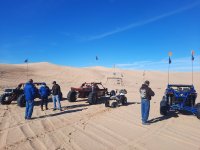- Thread starter
- #41
onanysunday
Well-known member
- May 7, 2021
- 3,750
- 3,445
Follow along with the video below to see how to install our site as a web app on your home screen.
Note: This feature may not be available in some browsers.
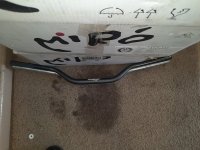
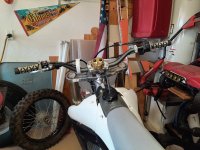
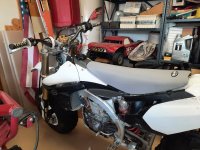
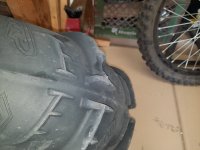
https://thumpertalk.com/forums/topic/360093-sand-suspension-set-up/Fork
Comp- run the clickers at about 4-6 from full hard. You need to have a stable chasis in the sand. Anything remotely soft will cause excess chasis movement and will wear you out fast.
Rebound- 18-20 A fast rebound is needed to let the fork extend as fast as possible to "reach out" to the next whoop. This will help the bike from falling down inbetween the whoops.
Shock
Comp run the low speed at about 4-6. see reason above for the need of stiff compression.
Rebound slow it down to 5-7. Since the rebound bleed path is bidirectional, this will add compression damping. Just watch for packing which will cause the rear to swap. If this is noticed, back out rebound 2 clicks at a time until it settles down.
I would rather have a rider commenting on a slightly harsh ride than to have him come back white as a ghost from trying to hold onto a bike that is bouncing all over the place.
Take Care, John
You probably saw this bike on Facebook. Belongs to my buddy Louis. We were camping together and he had seen my bike. I told him about BVC that does the Hondas. His CR had only been ridden 6 times and was sitting around not getting used. He just took it down to Tucson and had them do it up. Can't wait to go riding together.Been seeing ALLOT of Fat-Tire MX Bikes on teh FB this past week, this trend seems to be more popular then I recall in the past... :thumb:
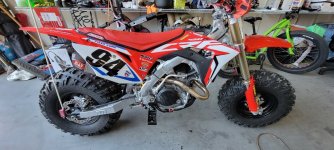
Sweet! Same tire setup I had. I do like the Carlisle knobby way better than the ribbed tire. Especially when you get in the ruts. You might want to check it out but I remember the Missle kit bikes being twitchy at high speeds because the shorter rake angle. Just what I remember hearing. It sure looks short just looking at it.xtracrispy said:Nice bike
Just picked this guy up for my Dad. 02 WR426 with the XFR kit. Can’t wait to try it in the sand. Let’s see if it drives me to get a missile kit for my 250r
View attachment 17604

Wonder how the big wheel would do with a smoothie front. In any case not going to change too much until we actually ride it. How did that folding triangle stand work, is it long enough to use with the hole in the swingarm?Sweet! Same tire setup I had. I do like the Carlisle knobby way better than the ribbed tire. Especially when you get in the ruts. You might want to check it out but I remember the Missle kit bikes being twitchy at high speeds because the shorter rake angle. Just what I remember hearing. It sure looks short just looking at it.
I don't think a smoothie would work well. When you push the bike hard into a corner I am thinking it would wash out.Wonder how the big wheel would do with a smoothie front. In any case not going to change too much until we actually ride it. How did that folding triangle stand work, is it long enough to use with the hole in the swingarm?
Yeah I've heard the complaints about the Missile kit handling, but they sure do look cool!


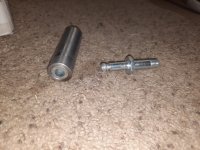
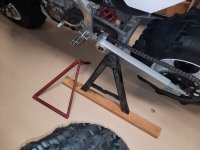
Good stuff. I did have bleeders on my KTM. Yes they are handy. I weigh 174 and guessing the suspension on this bike is all stock. I did loosen the nuts on the rear shock and dropped it down a little. Bike still sits high and I have long legs. Have not actually measured it yet. Been a long time since I have checked sag.There are some things you can try to make it less harsh over the small bumps. They vary in price, some are free.
1. Fork Air Bleeders. The air gap inside the fork develops pressure from temp changes, altitude, and just from the heat of riding. You can bleed them with a flathead screwdriver, or buy the little push button bleeders. The forks are more harsh when the air gap is pressurized. I press my little bleeders before every ride and often hear them hiss out pressurized air.
2. Lower the fork fluid height. Similar to above the air gap acts like a little buffer. Lowering the fluid height creates a bigger air gap which produces a smoother ride over the small bumps.
3. Set race sag for the rear shock. Most bikes like around 90-110mm but newer bikes might be different. Once you set the race sag, check the Free Sag. The idea is that if you have to crank down on the rear shock preload so much that your free sag is gone, that means you need a stiffer rear spring. If you ever see a racer pull up on the rear fender real gently when the bike is on the ground its them checking free sag. You can get a lot of info from that little amount of play. Sorta like how adjusting the fuel screw can give you info on the pilot jet.
4. Are they the stock fork springs? If you weigh more than 180lbs a lot of the bikes require stiffer springs. Newer bikes might be way different.
5. Fork clickers: Setting the rebound to fully stiff might not be the best choice. Assuming the front wheel weighs more than stock, that means it would take more force to change its direction and push it back down. So you would not want the rebound being too stiff and restricting. That can cause the forks to get stuck lower in their travel and produce a harsher ride. A similar thing happens if you back out the compression too much. You might expect the suspension to feel softer. But sometimes that can cause the forks to be further down in their stroke, and produce a harsh ride over the small bumps. All that is amplified if the spring rate is too soft for the rider.

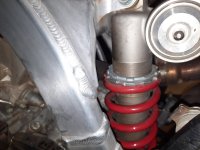
Well, With gear on it was at 83 mm or approx. 3.3 inches. I had already given it some more sag but it was still off by quite a bit. 100 mm is almost 4 inches so it dropped it another almost 3/4 inch. Thinking this will make a difference. Bike was twitchy at higher speeds. This pic is adjusted at 100mm.Well thats good news!!! I havnt checked my race sag in years either. Simple and free adjustment could make for a much nicer ride. When i got a stiffer rear spring i think it was a different color than stock. Could find an online picture of your bike and observe the spring color. Or maybe take a set of calipers to it. Or do nothing and just ride baby ride. Given the position of the locknut, with the weight of 175 and only 65mm of sag it wouldnt be crazy to assume thats a stiffer rear spring. I would of expected the locknut to be further down on the threads if its only sagging 65mm.
On paper just thinking about it that could be ideal for a fat tire bike. Stiffer spring for the heavier tire. But then back off the locknut until your sag is closer to what is recommended. Ive often seen around 100mm. More sag for straight line stability. Less sag turns better.
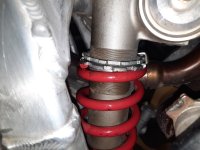
Your welcome to it. Debating on going down this week or not.I wanna try this thing!!!! It looks sooo fun!
